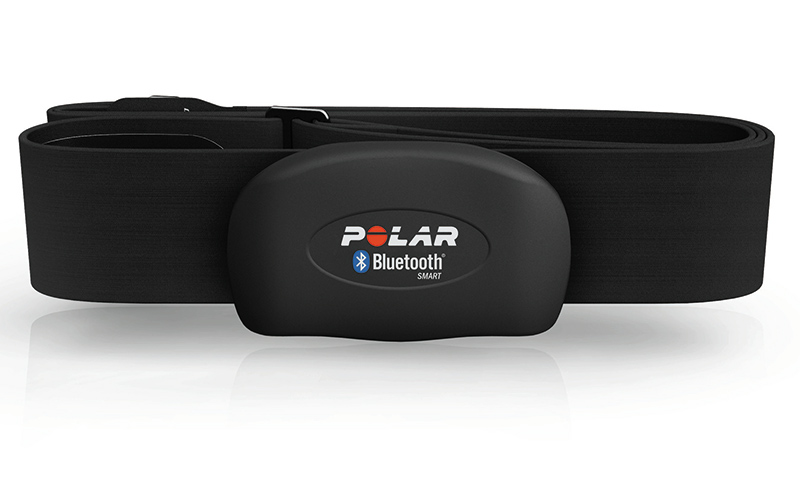
The Polar monitor detects a player’s current heart rate while training, helping players become smarter on the field. (Photo courtesy of Polar)
While coaching the women’s soccer team at St. Mary’s College of California, head coach Kai Edwards noticed something about his star player, Caroline Kruez. She was always out ahead of everybody. She would touch the sideline first in sprints, get to the ball before any opponent in a game and she never asked for a substitution.
Edwards had Kruez strap on a heart rate monitor for the first time and instantly he realized that even though she was outworking everyone else, she was only working at 75 percent of her maximum heart rate. Thanks to the data coming from the device, Kruez learned how to push herself even harder and get better results in her training.
Edwards, now the senior Elite Clubs National League (ECNL) director for Sereno Soccer Club in Arizona, recognized the benefits of these monitors and brought the technology to Sereno. Starting next season, Sereno’s Under-17 and Under-18 girls teams will begin to track their heart rates during training.
“It is a competition with yourself and pushing out of your comfort level,” Edwards said.
Edwards coached St. Mary’s women soccer from early 2009 until late 2014. He has been the director of Sereno Soccer Club since January and coaches Under-16 and Under-17 ECNL girls teams.
Sereno Soccer Club has been in existence since 1979 and continues to grow, with 90 competitive teams split across five regions in Arizona.
Edwards said the Polar heart rate monitors will be placed on the girls during the preseason that begins in late August. The devices are strapped around the players’ bodies underneath their shirts and placed below the sternum.
Fitness tests will help determine each player’s maximum and resting heart rates. According to Polar national training specialist Josh Simonsen, electronics are built into a pod, also called a transmitter, that takes electrical signals from the body. It then sends the data to a phone, laptop or other device for coaches to monitor.
“This will help their progress to be as fit as they can be, but in a healthy way,” Edwards said.
The heart-rate data will help coaches determine in real time which player needs a water break, who is pushing it and who needs to work on their overall fitness.
Post-training, overall team data will appear on the screen, enabling coaches to track progress over time.
“The monitors measure electrical pulses, which we believe is the most accurate way to measure heart rates,” Simonsen said.
Simonsen travels to meet with strength and conditioning coaches for collegiate and professional sports teams, including Major League Soccer.
He mentioned how an endurance athlete has aerobic fitness and an explosive athlete is anaerobic. The aerobic system provides energy at a slower rate for a long-term exercise, whereas the anaerobic system generates energy quickly and at a high intensity level.
“What’s beautiful about soccer is that you have to combine both,” Simonsen said.
The retail price for one Polar monitor with strap is $80. Edwards said Sereno’s goal is for every one of its nearly 3,000 players to purchase his or her own monitor to keep and use both inside and outside of Sereno training.
“For the girls on my team that have their own, they will text me before going on a run and ask where their heart rate should be at,” Edwards said.
For now, the Sereno 17- and 18-year-old girls teams will be using heart rate monitors donated by Orangetheory Fitness in Scottsdale Ranch. The fitness facility had switched to a new brand of monitors and donated the old monitors to Sereno after some Sereno players had gone to Orangetheory to try them out.
Simonsen said about 450 teams use Polar’s system and the majority are universities.
“Our responsibility is to give them as much education on this as possible,” Edwards said.
The players will learn that a high heart rate might not necessarily mean they are out of shape.
Recovery time will tell the difference, according to Simonsen. This refers to the heart’s ability to return to normal rate after being at a high intensity level.
He said if an athlete’s heart rate recovers quickly, then she is fit. If someone’s heart rate will take another 40 seconds or more to recover, then they need to improve their fitness level.
Edwards said athletes are responsible for their health off the field too. Stress, not enough sleep, or eating poorly can elevate one’s heart rate.
“They are accountable for the other 22 hours of the day,” Edwards said.
The system allows athletes to tailor their training based on their heart rates while offering guidelines to help keep them from pushing themselves too hard.
“Overtraining leads to injury, which is a big problem younger athletes have,” Simonsen said.
Dr. Kristina Wilson, pediatric primary care sports medicine physician at Phoenix Children’s Hospital, said the heart rate monitors are not necessary for young athletes but they are beneficial for knowing when to slow down in order to avoid injuries.
“Young athletes are pushed more than they’re ready for,” Wilson said.
Wilson also believes that if an athlete is really conditioned, there’s only so much improvement they can do.
“Once you peak in conditioning, you can’t improve your max anymore,” she said.
What you can improve on, however, is your recovery heart rate.
“Keeping the players in 55 to 80 percent of their max heart rate will avoid overworking,” she said.
Wilson sees overuse injuries all the time. When she diagnoses these injuries, she will tell the athlete to reduce activity so they can recover, but sometimes she will tell them to stop playing completely.
“We diagnose overtraining syndrome and it discourages kids from participating,” Wilson said. “We want kids to enjoy what there doing so they can do it for a long time.”